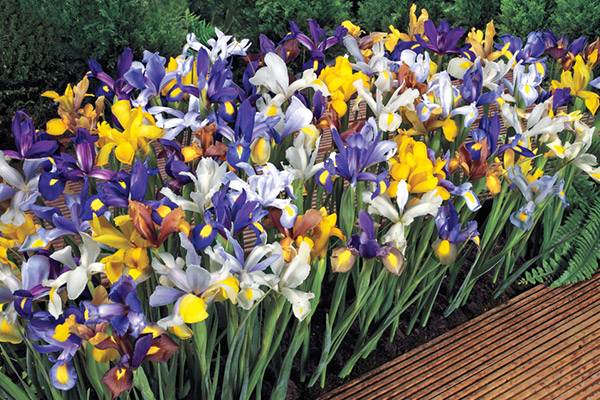It’s no wonder that iris are a favorite for gardens and vases. They’re easy-care plants with showy, colorful flowers. These classic flowers derive their name from the Greek goddess of rainbows, and for centuries they’ve been treasured for their brilliant colors and elegance. In fact, the iris flower is the basis for the fleur-de-lis, a decorative design popularized by the French monarchy.
Iris have captured the imagination of gardeners and artists alike. Vincent Van Gogh chose the elegant, colorful iris as the subject of several of his paintings. A symbol of faith, hope and wisdom, iris flowers are often given to people who may need uplifting and support. With its rich history, symbolism and elegance, it’s easy to see why gardeners consider these classics a must-have in the garden.
Iris Varieties
While you can choose from many types of iris, and the American Iris Society lists several divisions and subdivisions of iris, we’ve included the most popular types for American gardens below.
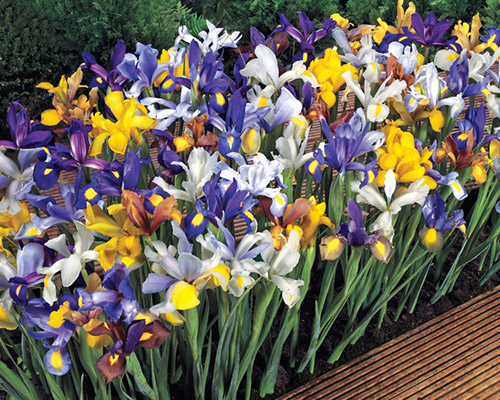
Dutch Iris Flowers
With their delicate style and striking color palettes, Dutch Iris are some of the most popular late-spring flowers. Their fan-shaped flowers, with three upright petals and three drooping petals, add elegance and beauty to sun-filled flower beds and borders. Like other iris, Dutch Iris flowers come in a range of hues, including bold blues and purples and vibrant reds and yellows. Dutch Iris tolerate a range of soil types, including acidic, clay, sandy and loamy, as long as it is well-drained. They’re easy care, too. After blooming, just cut the withered flower at the top of the stem to prevent seed production and then allow the leaves to wither and turn brown before removing them. The green leaves provide nourishment for the bulbs. They naturalize well and reliably return year after year. Dutch Iris bulbs are usually planted in the fall.
- Botanical Name: Iris hollandica
- Height: 20-24 inches tall
- Blooming Season: late spring to early summer
- Sun Exposure: plant in full sun to partial shade
- Growing Zones: 5-9
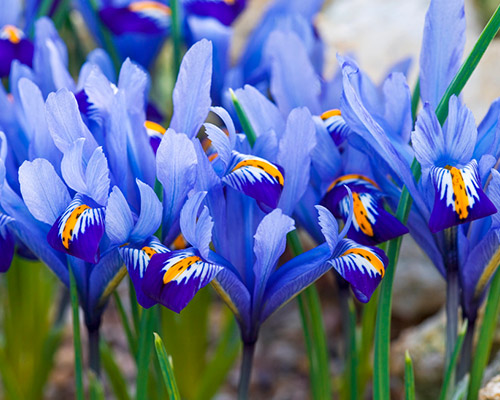
Dwarf Iris Flowers
These low-growing iris splash the early-season landscape with their delightful blue and purple, often fragrant, flowers. Like other iris flowers, Dwarf Iris have three large spreading petals, alternating with three erect, smaller standard petals. These darlings bloom before daffodils and tulips, and look best when planted in groups of three or more. Grown from bulbs and planted in the fall, Dwarf Iris grow best in well-drained soil and will tolerate acidic, clay, sandy and loamy soils. For best performance, remove the spent flowers after blooming.
- Botanical Name: Iris reticulata
- Height: 4-8 inches tall
- Blooming Season: late winter to early spring
- Sun Exposure: plant in full sun to partial shade
- Growing Zones: 4-9
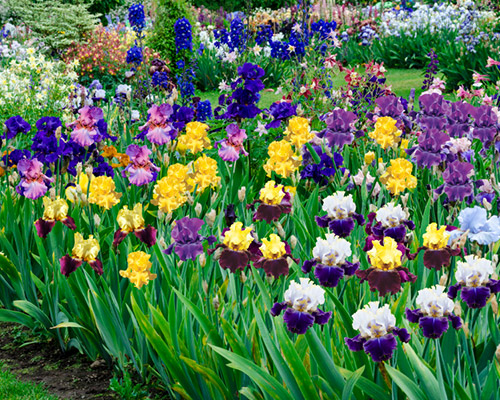
German Iris Flowers
Sometimes called Bearded Iris, German Iris are probably the showiest and easiest to grow of all the iris. And, the multitude of color choices–from blue, purple, red, yellow, pink, white and all the shades in between–make it easy to fit them into sunny, perennial flower beds. Their elegant, fan-shaped flowers have three drooping petals called falls and three upright petals called standards. Grown from rhizomes, these perennials are most often planted in the fall, but can also be planted in the spring. German Iris prefer well-drained soil and will tolerate acidic, clay, sandy and loamy soils. While German Iris are low-maintenance plants, we recommend removing the spent flower stems after blooming.
- Botanical Name: Iris germanica
- Height: 20-40 inches tall
- Blooming Season: mid spring, some rebloom in later summer
- Sun Exposure: plant in full sun to partial shade
- Growing Zones: 4-9
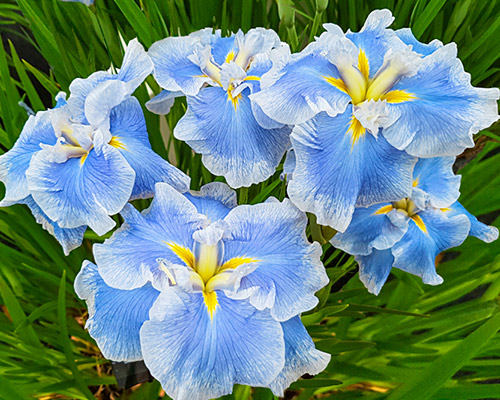
Japanese Iris Flowers
A favorite for planting in water gardens and near water features, Japanese Iris have elegant, beardless flowers with a flattened appearance. They’re available in a variety of colors including various shades of blue, purple, pink, red and white. These showy perennials are grown from rhizomes and often planted in the spring. They prefer well-drained soils and are easy-care. We recommend removing the spent flower stems after blooming.
- Botanical Name: Iris ensata
- Height: 24-48 inches tall
- Blooming Season: early summer
- Sun Exposure: plant in full sun to partial shade
- Growing Zones: 4-9
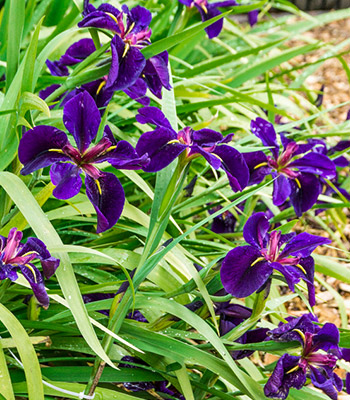
Louisiana Iris Flowers
A beardless iris that is best for warmer regions, Louisiana Iris bloom in early to midsummer and can be grown along ponds and streams. These charming perennials can also be grown in drier conditions, as long as the soil does not dry out completely. Louisiana Iris have beardless, fan-shaped flowers with three upright and three falling petals. They’re available in a range of colors, including blue, purple, pink and red. Grown from rhizomes, they are usually planted in the spring. For best performance, we recommend removing the spent flower stems after blooming.
- Botanical Name: Iris louisiana
- Height: 30-36 inches tall
- Blooming Season: early to midsummer summer
- Sun Exposure: plant in full sun to partial shade
- Growing Zones: 4-10
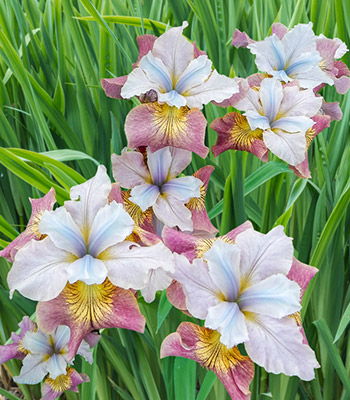
Siberian Iris Flowers
The Siberian Iris have some of the flashiest flowers and are a standout in sunny flower beds or near water features. The beardless flowers have the typical iris flower shape of three upright petals and three falling petals and are available in an array of color combinations, including many striking bicolors. Siberian Iris like moist to average soils and will tolerate clay, sandy, acidic and loamy soils. Grown from rhizomes, these perennials are usually planted in the spring. For best results, remove the spent flower stems after blooming.
- Botanical Name: Iris sibirica
- Height: 30-36 inches tall
- Blooming Season: early to midsummer summer
- Sun Exposure: Plant in full sun to partial shade
- Growing Zones: 3-9
Choosing Between Iris Types: Bulb vs Perennial
We’re often asked if iris are grown from bulbs or are they perennials? Here’s why there is some confusion. There are two basic types of iris: the bulbous iris, such as Dutch iris and Dwarf iris, and the perennial iris, such as German iris, Japanese iris, Louisiana iris, Siberian iris and the Yellow Flag iris.
Perennial iris grow from thick, fleshy roots, or rhizomes. When selecting iris for your garden, consider where you’d like to plant them, as well as their bloom times and colors.
How to Make the Most of Iris Season
K. van Bourgondien carries some of the best representatives of Dutch, Dwarf, German, Japanese, Louisiana and Siberian Iris. You’ll find some of the best flower colors and forms available. Because the bloom time can vary between the types, we recommend selecting several different types. That way you can enjoy months of iris blooms in the garden and fresh flower arrangements.
For more about growing and caring for iris, visit Iris Care Guide – Planting and Growing Iris Bulbs and Perennials.

